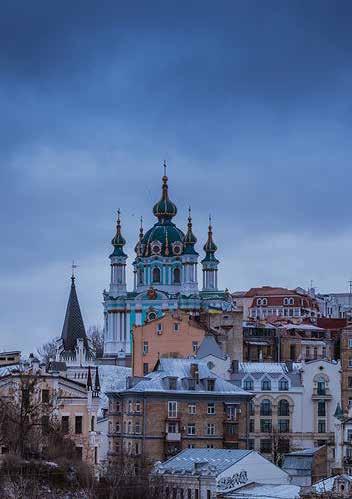
3 minute read
What’s Going On In Ukraine Overheard with Karen Smart: An Interview with the Over-
What is going on in Ukraine?
Why Ukraine? Contextualising Russia’s Invasion
Early in the morning on the 24th of February 2022, Russian President Vladimir Putin authorised a ‘special military operation’ in Ukraine. In essence, he claims that genocide is being committed against separatists in the Donetsk and Luhansk regions of eastern Ukraine. As a result, he has launched a devastating attack on Ukrainian territory. This decision has drawn global condemnation and various sanctions have caused the Moscow stock exchange to close and the Russian ruble to collapse. Many have claimed that this is the first major conflict in Europe since WWII, but this neglects the years of war that has plagued the Balkan nations of former Yugoslavia and Kosovo. Additionally, this conflict has brought the legitimacy of international law into question much like the 2003 US invasion of Iraq. While this does not disregard the significance of Ukraine’s current situation, it is crucial to bear in mind that hard power is still utilised in a supposedly post-war modern world.
The Main Players
Russia and Ukraine have a long and complicated history spanning over four centuries. This current violent outbreak is the result of almost a decade of tension beginning with Ukraine’s Revolution of Dignity in 2013-14. The revolution saw elected, Russia-friendly President Yanukovych ousted. In response Putin annexed the Ukrainian Crimean Peninsula in 2014. In turn, this annexation motivated Ukraine to forge closer ties with NATO, the EU, and the West. As a former component state of the Soviet Republic, Ukraine is angering Russia in wavering from Moscow’s influence.
While Russia and Ukraine are the main players in this conflict, it is important to consider which countries have allied with either side. Notably, former Soviet Union states such as Belarus and Kazakhstan have sided with Russia. In contrast, NATO countries including the UK, US, France, Italy, Canada, and others have voiced support for Ukraine. Other major powers, such as India and China, have attempted to remain neutral.
Russia’s Goal
To many, Russia’s goal in invading Ukraine may not be immediately clear. Putin is motivated by pre-soviet-era Russocentric views of Europe, as well as NATO’s growing influence and conflict in eastern Ukraine. Although NATO was devised as a military alliance with the aim of ensuring peace in Europe, the organisation’s perceived aggression in eastward expansion of membership concerns Russia, along with the organisation’s involvement in former Yugoslavia and the greater Middle East. Additionally, some may argue,that the perceived success of Ukraine as a modern, democratic, independent state threatens Russia’s autocracy, as it presents an alternative model of government. Russia has issued a series of demands in order to end its ‘peacekeeping’ mission in Ukraine. The Kremlin has claimed that it will end military operations immediately if Kyiv meets that list of conditions. However, they contentiously include ceding Crimea as Russian territory, acknowledging the independence of the Donetsk and Luhansk regions, and enshrining neutrality in the Ukrainian constitution.
Developments So Far
At time of writing, more than 1.7 million Ukrainians have fled the nation, making this the fastest-growing European refugee crisis since WWII. At least three rounds of ceasefire talks have failed, but Ukraine has held its own against almost two weeks of Russian onslaught. While they have provided Ukraine with weapons and diplomatic support, NATO and western allies will not send troops from fears of initiating a nuclear war. The outcome of this conflict is not clear, but regardless, the result will be significant for the future of the global political order.
Words by Alexandra Herden









